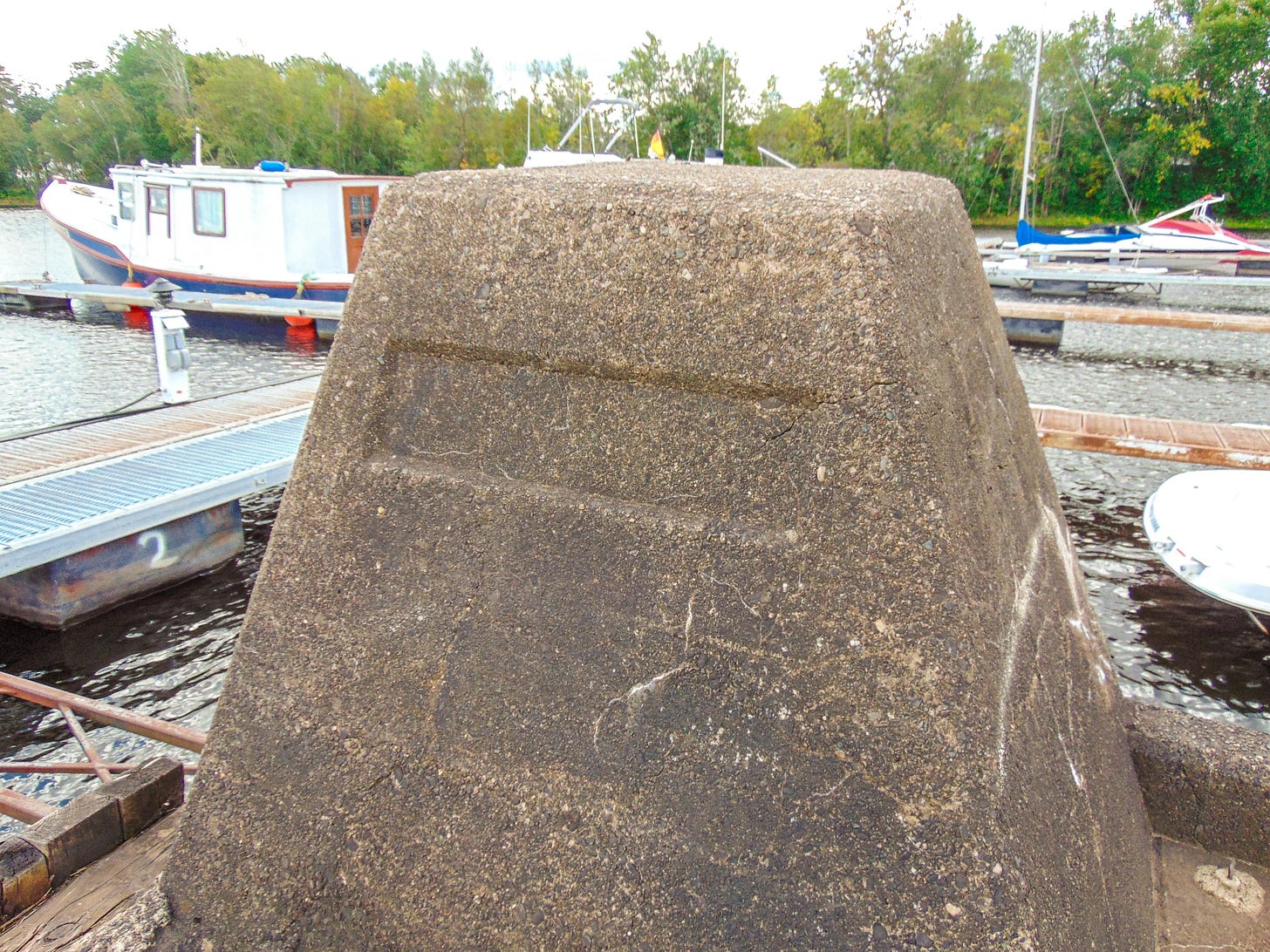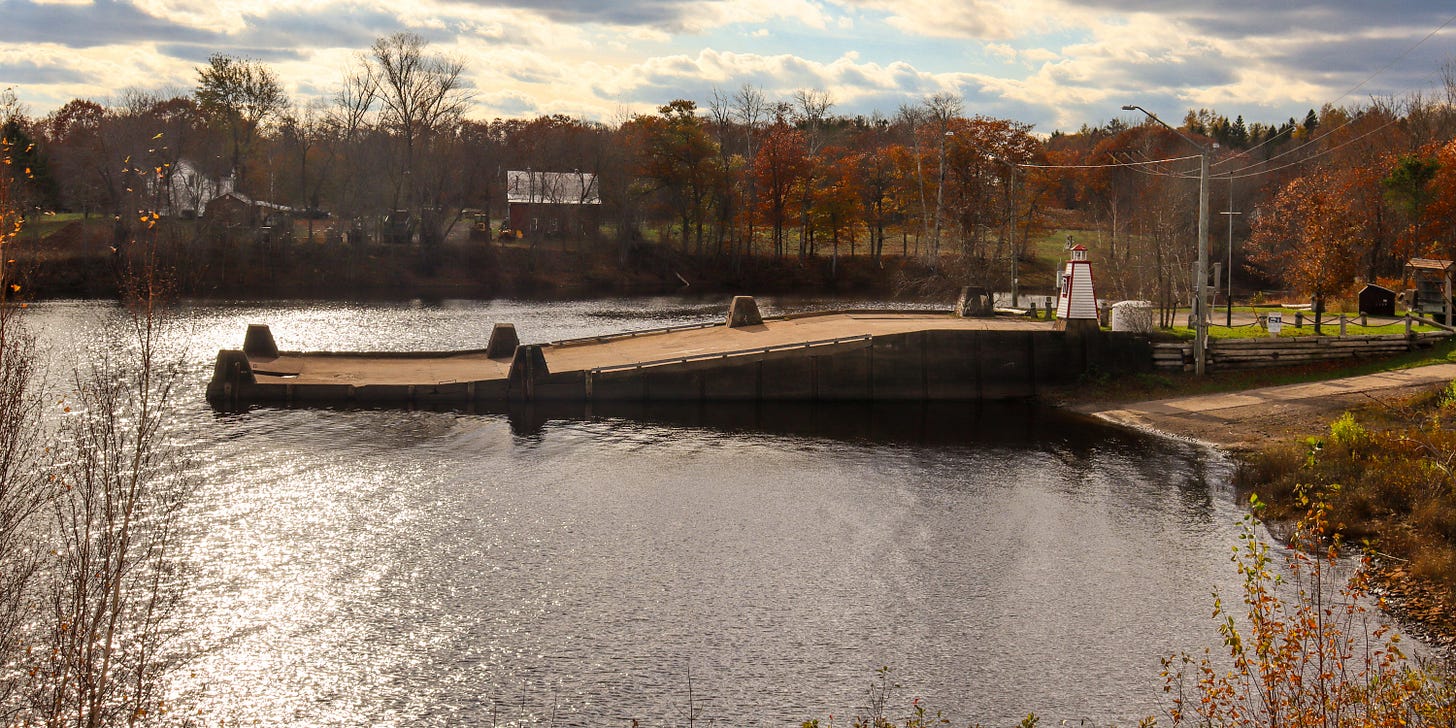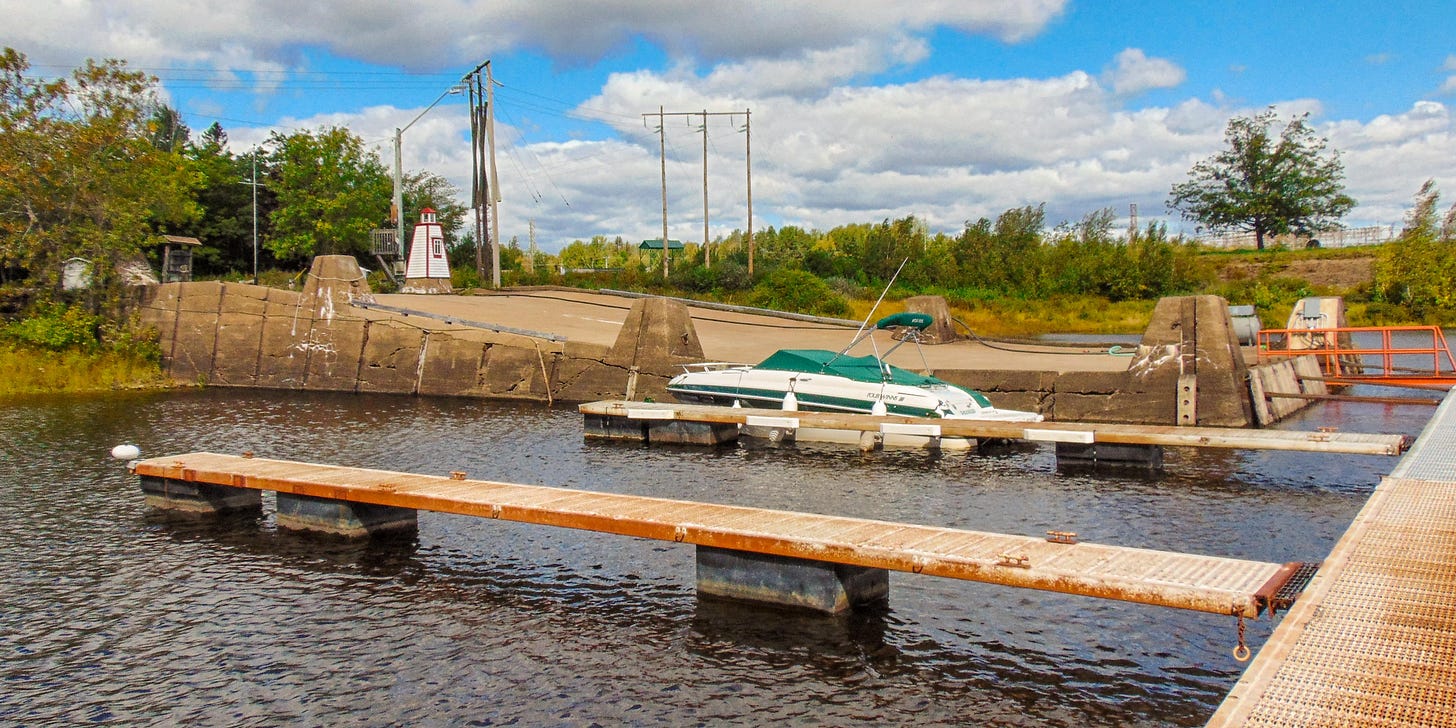Newcastle Creek Wharf
Newcastle Creek is a graded wharf on Grand Lake, a tributary of the Lower Wolastoq or St. John River. It is the northern-most remaining steamboat wharf in the network and is one half of a pair of high and low water wharves that sat beside the former Grand Lake generating station in Minto.
Newcastle Creek is 18 meters wide at the face and extends 40 meters from shore. It is a graded wharf, so the deck is pitched to gradually descend from a high water level at the shore to a low water level at the face. Originally flanked on either side by eight inset bollards, one of the bollards on the upriver side was been relocated to the shore after it became dislodged at some point in the past. Another bollard on the upriver side, the one closest to shore, has been modified into the base of a miniature lighthouse.
The other remaining bollards are in relatively good shape. None display any engravings displaying the wharf’s name or date of installation, but the front corner bollard on the downriver side does have a section which may have displayed the wharf’s name at some point. If this was ever the case, it has long since been worn away.

The face of the wharf has been modified to allow a floating dock to be attached in the summertime and approximately half the wharf face is covered in wood sheathing. It is uncommon for wharves with bollards to have sheathing like this, and it is possible this feature was added as part of the renovations to adapt the wharf for marina use. When the floating jetty is present, a gangplank is laid across the cargo slip at the centre of the wharf in much the same way as the it would have been used by the steamships.
Although details about the early life of the Newcastle Creek Wharf are fairly scarce, the wharf was likely constructed shortly after land was acquired by the province for use as a public landing in 1871.1 A description of repairs on the wharf performed between 1898 and 1899 confirm that Newcastle Creek was 17 meters wide at the face, approximately the same width as it is today.2
Despite the similar width, it is likely that the wooden iteration of the wharf was not graded. In 1909, the wharf is specifically referred to by the province as a low water wharf.3 The federal government also begins planning for the construction of an adjacent high water wharf in this year,4 indicating that even if there was a grade on the original wharf, it was insufficient for the wharf to be usable in seasonal high water conditions.
The adjacent high water wharf was constructed in early 1910 and employed an L-shape design. It was considerably smaller than its low water counterpart. The wharf’s pierhead was only approximately 12 meters wide and the entire length of the wharf was only 18 meters.5 When the federal government assumed ownership of the low water wharf in 1923,6 it is possible that the high water wharf fell into disuse as it would have been made redundant once the low water wharf was upgraded with concrete and (presumably) made into a graded wharf sometime in the 1930s.
The high water wharf is not mentioned in future Sailing Directions or Small Craft Guides and when the federal government divested itself of the remaining steamboat wharves in the 1990s, only the low water graded wharf was included in the inventory. It is also possible that the wharf was demolished as part of the construction of the Grand Lake generating station in 1931, NB Power’s first thermal power plant, which sat just to the north of the wharf until 2012.7

Today, the wharf is maintained by the Grand Lake Boater’s club and serves as a marina in the summertime when a floating dock is harnessed to the front of the wharf. The wharf is accessible to both club members and the general public for us at their own risk and there is an adjacent boat launch on the upriver side of the wharf. Newcastle Creek is also the only remaining wharf in the boundaries of the Municipality of Grand Lake — the local government encompassing the former villages of Minto and Chipman — but there are a number of wharves elsewhere on the lake.
Having only ever visited the wharf in recent years, it is difficult for me to imagine how different it must have looked, felt, and smelled while the coal-fired power plant dominated most of the landscape. Today the land formerly occupied by the plant is greenspace and its trails provide a great view of the lake and wharf. The wharf’s persistence even after the closure and demolition of the plant is perplexing. Coal was being mined in Minto long before the wharf’s construction and yet the Newcastle Creek Wharf has survived beyond the closure of the the coal mines and the generation station which kept the local industry operating into the 21st century.8 The steamboats may be gone, but wharves like Newcastle Creek have proven capable of adapting to new purposes.
Seventeenth Annual Report of the Chief Commissioner of Public Works in Journal of the House of Assembly of the Province of New Brunswick (Fredericton, New Brunswick: G. E. Fenety, Printer to the Queen’s Most Excellent Majesty, 1872), 4 (472).
Report of the Minister of Public Works on the Works Under his Control for the Fiscal Year Ended June 30, 1899 — Chief Engineer’s Report in Sessional Papers of the Fifth Session of the Eighth Parliament of the Dominion of Canada Volume 8 (Ottawa, Ontario: S.E. Dawson, Printer to the King’s Most Excellent Majesty, 1900), 66.
Report of the Chief Commissioner of Public Works in Journal of the House of Assembly of the Province of New Brunswick (Fredericton, New Brunswick: [Printer unknown], 1909), 90; Citation information is fragmentary because I am referencing scans of just the Report of Public Works provided by the Legislative Library that do not include container information about the Journal.
Report of the Minister of Public Works on the Works Under his Control for the Fiscal Year Ended March 31, 1910 — Chief Engineer’s Report in Sessional Papers of the Third Session of the Eleventh Parliament of the Dominion of Canada Volume 11 (Ottawa, Ontario: C. H. Parmelee, Printer to the King’s Most Excellent Majesty, 1910), 72.
Report of the Minister of Public Works on the Works Under his Control for the Fiscal Year Ended March 31, 1910 — Chief Engineer’s Report, 72.
John McLaughlin, “Grand Lake generating station to close early",” News Release, Government of New Brunswick, March 10, 2010, https://www2.gnb.ca/content/gnb/en/news/news_release.2010.03.0340.html; Staff, “NB Power pulls plug on Grand Lake station,” CBC News, September 29, 2009, https://www.cbc.ca/news/canada/new-brunswick/nb-power-pulls-plug-on-grand-lake-station-1.815214; Staff (with files from Nick Moore), “Demolition day for a piece of history in New Brunswick, CTV Atlantic, April 19, 2012, https://atlantic.ctvnews.ca/demolition-day-for-a-piece-of-history-in-new-brunswick-1.798619; Khalil Aktar, “Power station brought Grand Lake into modern era with 'flick of a switch,’” CBC News, July 21, 2024, https://www.cbc.ca/news/canada/new-brunswick/grand-lake-power-station-1.7269132.
Staff, “Minto coal jobs granted reprieve,” CBC News, July 22, 2004, https://www.cbc.ca/news/canada/new-brunswick/minto-coal-jobs-granted-reprieve-1.477871; Judith House and David L. Myles, The New Brunswick Electric Power Commission (1920-1990): Seventy Years of Service, (Fredericton, New Brunswick: NB Power, 1990), https://www.nbpower.com/media/1489688/seventy-years-of-service.pdf, 21.









